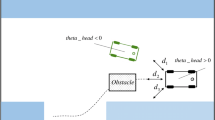Abstract
The trending and spotlight research in the field of mobile robots in an indoor environment is the parking of autonomous multi-mobile robots. The proposed research work presents a co-operative, unified autonomous multi-robot system (MRS) for parking in the indoor environment. In the research work, initially MRS establishes by themselves a flock using the behavioral control mechanism and is capable of swapping leadership behavior based on event-driven conditions. The Real time challenges of MRS flocking in an indoor environment are parking and obstacle avoidance with rendezvous approach. In this regard, the proposed hardware-based accelerators for MRS flock have been developed using Verilog HDL and deployed on Field Programmable Gate Array (FPGA) to perform obstacle avoidance with rendezvous and parking at versatile modes. In the process of parking by MRS, the leader evaluates parking slot dimensions and drives the flock towards the parking. Due to versatile parking modes, the MRS can park in parallel/perpendicular and angular parking. The proposed approach has been implemented and validated with experiments using Vivado tools and Xilinx FPGA Zynq-7000 SoC ZC702.













Similar content being viewed by others
Data availability
Not applicable.
References
Agarwal Y, Ratnani P, Shah U, Jain P (2021) “IoT based Smart Parking System,” 2021 5th International Conference on Intelligent Computing and Control Systems (ICICCS), pp. 464–470
Aljohani M, Olariu S, Alali A, Jain S (2022) A survey of parking solutions for smart cities. IEEE Trans Intell Transp Syst 23(8):10012–10029
Anagnostopoulos T et al (2021) Challenges and solutions of surveillance systems in IoT-enabled smart campus: a survey. IEEE Access 9:131926–131954
Cheng Z, Li B, Liu B (2022) Research on path planning of mobile robot based on dynamic environment. IEEE Int Confer Mechatron Autom (ICMA) 2022:140–145
Choset H, Lynch KM, Hutchinson S, Kantor GA, Burgard W, Kavraki LE, Thrun S (2005) “Bug Algorithms,” in Principles of Robot Motion: Theory, Algorithms, and Implementations, MIT Press, pp.17–38
Gong Z, Li J, Luo Z, Wen C, Wang C, Zelek J (2021) Mapping and semantic modeling of underground parking lots using a backpack LiDAR system. IEEE Trans Intell Transp Syst 22(2):734–746
Han J, Kim J, Shim DH (2019) Precise localization and mapping in indoor parking structures via parameterized SLAM. IEEE Trans Intell Transp Syst 20(12):4415–4426
Jhang J-H, Lian F-L (2020) An autonomous parking system of optimally integrating bidirectional rapidly exploring random trees* and parking-oriented model predictive control. IEEE Access 8:163502–163523
Leu J, Wang Y, Tomizuka M, Di Cairano S (2022) Autonomous vehicle parking in dynamic environments: an integrated system with prediction and motion planning. Int Confer Robotics Autom (ICRA) 2022:10890–10897
Li B, Yang L, Xiao J, Valde R, Wrenn M, Leflar J (2018) Collaborative mapping and autonomous parking for multi-story parking garage. IEEE Trans Intell Transp Syst 19(5):1629–1639
Li B et al (2022) Optimization-based trajectory planning for autonomous parking with irregularly placed obstacles: a lightweight iterative framework. IEEE Trans Intell Transp Syst 23(8):11970–11981
Lin T, Rivano H, Le Mouël F (2017) A survey of smart parking solutions. IEEE Trans Intell Transp Syst 18(12):3229–3253
Liu Y (2022) A laser intensity based autonomous docking approach for mobile robot recharging in unstructured environments. IEEE Access 10:71165–71176
Ma S, Jiang H, Han M, Xie J, Li C (2017) Research on automatic parking systems based on parking scene recognition. IEEE Access 5:21901–21917
Naji B, Abdelmoula C, Masmoudi M (2022) A real time algorithm for versatile mode parking system and its implementation on FPGA board. Appl Sci 12(2):655
Ozsoyeller D, Tokekar P (2022) Multi-robot symmetric rendezvous search on the line. IEEE Robot Autom Lett 7(1):334–341
Pushpangathan JV, Kandath H, Dutta R, Bardhan R, Senthilnath J (2022) “Robust consensus of higher-order multi-agent systems with attrition and inclusion of agents and switching topologies” arXiv preprint arXiv:2202.06261
Upadhyay S, Ratnoo A (2018) A point-to-ray framework for generating smooth parallel parking maneuvers. IEEE Robot Autom Lett 3(2):1268–1275
Vundurthy B, Sridharan K (2020) Protecting an autonomous delivery agent against a vision-guided adversary: algorithms and experimental results. IEEE Trans Industr Inf 16(9):5667–5679
Wan Z, Yu B, Li TY, Tang J, Zhu Y, Wang Y, Raychowdhury A, Liu S (2021) A survey of FPGA-based robotic computing. IEEE Circuits Syst Mag 24:48–74
Wan Z et al (2021) “A Survey of FPGA-Based Robotic Computing.” in IEEE Circuits and Systems Magazine, 21(2):48–74, Second quarter
Wan Z et al (2022) “Robotic Computing on FPGAs: Current Progress, Research Challenges, and Opportunities,” 2022 IEEE 4th International Conference on Artificial Intelligence Circuits and Systems (AICAS), pp. 291–295
Yu J, LaValle SM, Liberzon D (2012) Rendezvous without coordinates. IEEE Trans Autom Control 57(2):421–434
Zhang J, Chen H, Song S, Hu F (2020) Reinforcement learning-based motion planning for automatic parking system. IEEE Access 8:154485–154501
Acknowledgements
The Authors are thankful to the Science and Engineering Research Board, New Delhi, INDIA for funding this work as part of project entitled "A Companion type Assistive System for Elderly People using VLSI based Service Robot” under the Science and Engineering Research Board (SERB-ECR).
Author information
Authors and Affiliations
Corresponding author
Additional information
Publisher's Note
Springer Nature remains neutral with regard to jurisdictional claims in published maps and institutional affiliations.
Rights and permissions
Springer Nature or its licensor (e.g. a society or other partner) holds exclusive rights to this article under a publishing agreement with the author(s) or other rightsholder(s); author self-archiving of the accepted manuscript version of this article is solely governed by the terms of such publishing agreement and applicable law.
About this article
Cite this article
Vani, G.D., Karumuri, S.R., Chinnaiah, M.C. et al. A co-operative type of multi-robot parking system with versatile mode and implementation using FPGA. Microsyst Technol 29, 1515–1528 (2023). https://doi.org/10.1007/s00542-023-05525-7
Received:
Accepted:
Published:
Issue Date:
DOI: https://doi.org/10.1007/s00542-023-05525-7




